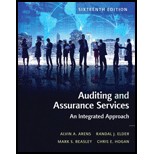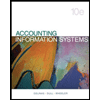
Auditing and Assurance Services (16th Edition)
16th Edition
ISBN: 9780134065823
Author: Alvin A. Arens, Randal J. Elder, Mark S. Beasley, Chris E. Hogan
Publisher: PEARSON
expand_more
expand_more
format_list_bulleted
Question
Chapter 2, Problem 17DQP
To determine
Identify the applicable element of quality control for the procedures given from the quality control manual of a CPA firm.
Expert Solution & Answer
Want to see the full answer?
Check out a sample textbook solution
Students have asked these similar questions
I need help solving this general accounting question with the proper methodology.
I need help with this general accounting problem using proper accounting guidelines.
I need help with this general accounting question using the proper accounting approach.
Chapter 2 Solutions
Auditing and Assurance Services (16th Edition)
Ch. 2 - Prob. 1RQCh. 2 - Prob. 2RQCh. 2 - Prob. 3RQCh. 2 - Prob. 4RQCh. 2 - Prob. 5RQCh. 2 - Prob. 6RQCh. 2 - Prob. 7RQCh. 2 - Prob. 8RQCh. 2 - Prob. 9RQCh. 2 - Prob. 10RQ
Ch. 2 - Prob. 11RQCh. 2 - State what is meant by the term peer review. What...Ch. 2 - Prob. 13.1MCQCh. 2 - Prob. 13.2MCQCh. 2 - Prob. 13.3MCQCh. 2 - Prob. 14.1MCQCh. 2 - Prob. 14.2MCQCh. 2 - Prob. 14.3MCQCh. 2 - Prob. 15.1MCQCh. 2 - Prob. 15.2MCQCh. 2 - Prob. 15.3MCQCh. 2 - Prob. 16DQPCh. 2 - Prob. 17DQPCh. 2 - Prob. 18DQPCh. 2 - Prob. 19DQPCh. 2 - Prob. 21DQP
Knowledge Booster
Similar questions
- Green, an individual taxpayer who is not a day trader, has requested assistance from a CPA to calculate Year 2 gains and/or losses on the sale of various shares of stock. For each of the following transactions, calculate the correct gain or loss and enter the amount in the associated box in the Gain or Loss column. 4. Sold 1,225 shares of ABC Corp. stock at $9 per share. Green purchased 600 shares several years ago at $30 per share. Three years ago, when the stock price was $21, there was a 2-for-1 stock split, and two years ago, when the stock price was $25, there was a 3-for-2 stock split. No other shares were sold by Green before Year 2. 5. Sold 500 shares of XYZ Corp. stock at $20 per share. Green purchased these shares two years prior at $22 per share. Three weeks prior to the sale, Green purchased 100 shares of XYZ stock at $18 per share. 6. Sold 1,600 shares of BX Corp. stock at $4 per share. Green received these shares as a gift from his sister four years ago. The fair market…arrow_forwardAlessandra Manufacturing produces various electronic components. Last year, the company's variable costing net operating income was $92,400, and ending inventory increased by 1,800 units. Fixed manufacturing overhead cost per unit was $5. Determine the absorption costing net operating income for last year.arrow_forwardGreen, an individual taxpayer, who is not a day trader, has requested assistance from a CPA to calculate Year 2 gains and/or losses on the sale of various shares of stock. For each of the following transactions, calculate the correct gain or loss and enter the amount in the associated box in the Gain or Loss column. 1. Sold 200 shares of Y Corp. stock at $14 per share. Green received the 200 shares as a gift from his brother three years ago, when the shares had a fair market value of $10 per share. Green's brother purchased the stock for $16 per share. 2. Sold 200 shares of Y Corp. stock at $22 per share. Green received the 200 shares as a gift from his brother three years ago, when the shares had a fair market value of $26 per share. Green's brother purchased the stock for $16 per share. 3. Sold 450 shares of Z Corp. stock at $40 per share. Green received the 450 shares from his aunt's estate as a bequest. The fair market value of the stock at the date of his aunt's death was $32 per…arrow_forward
- Gross profit would be_.arrow_forwardWhat is Bobby's 2019 net income using accrual accounting?arrow_forwardJob 786 was one of the many jobs started and completed during the year. The job required $8,400 in direct materials and 35 hours of direct labor time at a total direct labor cost of $9,300. If the job contained five units and the company billed at 70% above the unit product cost on the job cost sheet, what price per unit would have been charged to the customer?arrow_forward
- What is the company's gross profit?arrow_forwardMOH Cost: Top Dog Company has a budget with sales of 7,500 units and $3,400,000. Variable costs are budgeted at $1,850,000, and fixed overhead is budgeted at $970,000. What is the budgeted manufacturing cost per unit?arrow_forwardWhat was Ghana's cost of goods sold for 2023?arrow_forward
arrow_back_ios
SEE MORE QUESTIONS
arrow_forward_ios
Recommended textbooks for you
 Auditing: A Risk Based-Approach to Conducting a Q...AccountingISBN:9781305080577Author:Karla M Johnstone, Audrey A. Gramling, Larry E. RittenbergPublisher:South-Western College Pub
Auditing: A Risk Based-Approach to Conducting a Q...AccountingISBN:9781305080577Author:Karla M Johnstone, Audrey A. Gramling, Larry E. RittenbergPublisher:South-Western College Pub Auditing: A Risk Based-Approach (MindTap Course L...AccountingISBN:9781337619455Author:Karla M Johnstone, Audrey A. Gramling, Larry E. RittenbergPublisher:Cengage Learning
Auditing: A Risk Based-Approach (MindTap Course L...AccountingISBN:9781337619455Author:Karla M Johnstone, Audrey A. Gramling, Larry E. RittenbergPublisher:Cengage Learning Pkg Acc Infor Systems MS VISIO CDFinanceISBN:9781133935940Author:Ulric J. GelinasPublisher:CENGAGE L
Pkg Acc Infor Systems MS VISIO CDFinanceISBN:9781133935940Author:Ulric J. GelinasPublisher:CENGAGE L

Auditing: A Risk Based-Approach to Conducting a Q...
Accounting
ISBN:9781305080577
Author:Karla M Johnstone, Audrey A. Gramling, Larry E. Rittenberg
Publisher:South-Western College Pub

Auditing: A Risk Based-Approach (MindTap Course L...
Accounting
ISBN:9781337619455
Author:Karla M Johnstone, Audrey A. Gramling, Larry E. Rittenberg
Publisher:Cengage Learning


Pkg Acc Infor Systems MS VISIO CD
Finance
ISBN:9781133935940
Author:Ulric J. Gelinas
Publisher:CENGAGE L